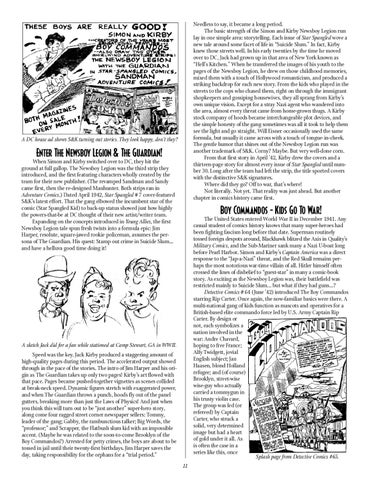Needless to say, it became a long period. The basic strength of the Simon and Kirby Newsboy Legion run lay in one simple area: storytelling. Each issue of Star Spangled wove a new tale around some facet of life in “Suicide Slum.” In fact, Kirby knew those streets well. In his early twenties by the time he moved over to DC, Jack had grown up in that area of New York known as “Hell’s Kitchen.” When he transferred the images of his youth to the pages of the Newsboy Legion, he drew on those childhood memories, mixed them with a touch of Hollywood romanticism, and produced a striking backdrop for each new story. From the kids who played in the streets to the cops who chased them, right on through the immigrant shopkeepers and gossiping housewives, they all sprang from Kirby’s own unique vision. Except for a stray Nazi agent who wandered into the area, almost every threat came from home-grown thugs. A Kirby stock company of hoods became interchangeable plot devices, and the simple honesty of the gang sometimes was all it took to help them see the light and go straight. Will Eisner occasionally used the same formula, but usually it came across with a touch of tongue-in-cheek. The gentle humor that shines out of the Newsboy Legion run was another trademark of S&K. Corny? Maybe. But very well-done corn. From that first story in April ’42, Kirby drew the covers and a thirteen-page story for almost every issue of Star Spangled until number 30. Long after the team had left the strip, the title sported covers with the distinctive S&K signatures. Where did they go? Off to war, that’s where! Not literally. Not yet. That reality was just ahead. But another chapter in comics history came first.
A DC house ad shows S&K turning out stories. They look happy, don’t they?
Enter The Newsboy Legion & The Guardian! When Simon and Kirby switched over to DC, they hit the ground at full gallop. The Newsboy Legion was the third strip they introduced, and the first featuring characters wholly created by the team for their new publisher. (The revamped Sandman and Sandy came first, then the re-designed Manhunter. Both strips ran in Adventure Comics.) Dated April 1942, Star Spangled # 7 cover-featured S&K’s latest effort. That the gang elbowed the incumbent star of the comic (Star Spangled Kid) to back-up status showed just how highly the powers-that-be at DC thought of their new artist/writer team. Expanding on the concepts introduced in Young Allies, the first Newsboy Legion tale spun fresh twists into a formula epic: Jim Harper, resolute, square-jawed rookie policeman, assumes the persona of The Guardian. His quest: Stamp out crime in Suicide Slum... and have a helluva good time doing it!
Boy Commandos - Kids Go To War! The United States entered World War II in December 1941. Any casual student of comics history knows that many super-heroes had been fighting fascism long before that date. Superman routinely tossed foreign despots around, Blackhawk blitzed the Axis in Quality’s Military Comics, and the Sub-Mariner sank many a Nazi U-boat long before Pearl Harbor. Simon and Kirby’s Captain America was a direct response to the “Jap-a-Nazi” threat, and the Red Skull remains perhaps the most notorious war-time villain of all. Hitler himself often crossed the lines of disbelief to “guest-star” in many a comic-book story. As exciting as the Newsboy Legion was, their battlefield was restricted mainly to Suicide Slum... but what if they had guns...? Detective Comics # 64 (June ’42) introduced The Boy Commandos starring Rip Carter. Once again, the now-familiar basics were there. A multi-national gang of kids function as mascots and operatives for a British-based elite commando force led by U.S. Army Captain Rip Carter. By design or not, each symbolizes a nation involved in the war: Andre Chavard, hoping to free France; Alfy Twidgett, jovial English subject; Jan Haasen, blond Holland refugee; and (of course) Brooklyn, street-wise wise-guy who actually carried a tommygun in his trusty violin case. The group was led (or refereed) by Captain Carter, who struck a solid, very determined image but had a heart of gold under it all. As is often the case in a series like this, once Splash page from Detective Comics #65.
A sketch Jack did for a fan while stationed at Camp Stewart, GA in WWII. Speed was the key. Jack Kirby produced a staggering amount of high-quality pages during this period. The accelerated output showed through in the pace of the stories. The intro of Jim Harper and his origin as The Guardian takes up only two pages! Kirby’s art flowed with that pace. Pages became pushed-together vignettes as scenes collided at break-neck speed. Dynamic figures stretch with exaggerated power, and when The Guardian throws a punch, hoods fly out of the panel gutters, breaking more than just the Laws of Physics! And just when you think this will turn out to be “just another” super-hero story, along come four ragged street corner newspaper sellers: Tommy, leader of the gang; Gabby, the rambunctious talker; Big Words, the “professor;” and Scrapper, the Flatbush slum kid with an impossible accent. (Maybe he was related to the soon-to-come Brooklyn of the Boy Commandos?) Arrested for petty crimes, the boys are about to be tossed in jail until their twenty-first birthdays. Jim Harper saves the day, taking responsibility for the orphans for a “trial period.” 11
